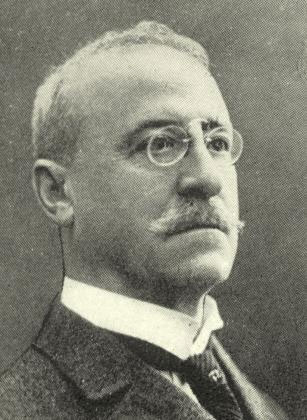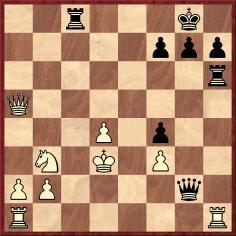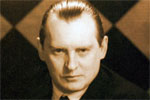Chess Explorations (26)
By Edward Winter
Missed mates
In C.N. 6280 Frederick S. Rhine (Park Ridge, IL, USA) drew attention to page
96 of On Top of the Chess World by L. Christiansen, J. Fedorowicz and
I. Gurevich (San Francisco, 1995), where Gurevich annotated the 14th match-game
between Kasparov and Anand:
Anand’s 17...Qc7 received this comment by Gurevich:
‘Black could not do without this move, since 17...f6 18 Nd3 Nb6? is
bad due to 19 Be1! Qb5 19 [sic] Nc5.’

Mr Rhine commented: ‘20...Qxf1 mate would be a strong rejoinder.’
Another recent item, C.N. 6276, remarked that there cannot be many books by
a master in which a move awarded an exclamation mark allows mate in one. From
page 95 of The Fireside Book of Chess by I. Chernev and F. Reinfeld (New
York, 1949):

Concerning the references to ‘the authors’ comment’ and ‘the
analysts’, it should be noted that the eighth edition of the book in question,
Kleines Lehrbuch des Schachspiels, was published in 1910, i.e. some 17
years after Dufresne’s death. The title page stated ‘Kleines
Lehrbuch des Schachspiels. Von Jean Dufresne. Achte verbesserte Auflage.
Herausgegeben von Jacques Mieses’.
Below is the relevant section of page 398, in a note to 8 e3:

In C.N. 6288 Andreas Saremba (Brieselang, Germany) noted that the seventh edition
of the book (1901) had only six pages of variations on the Queen’s Gambit
(as opposed to 13 pages in the eighth edition) and did not even mention the Tarrasch
Defence (3...c5). Moreover, the error in the eighth edition was corrected on
page 397 of the ninth edition, published in 1916, through the interposition
of ...Bb4+ before ...Ne7:

As mentioned in C.N. 6276, the following different amendment appeared on page
397 of the tenth edition, published in 1923:


Jacques Mieses
In C.N. 2117 Richard Forster (Zurich) referred to the position which arose
after White’s 25th move in Réti v Marshall, New York, 1924 (see pages
165-166 of the English-language tournament book, published in 1925):
Play went 25...Nxg3 26 Rhg1, and Alekhine wrote: ‘Or 26 hxg3 Qxg3+ 27
Ke2 Qg2+ 28 Kd3 Rxh1 29 Rxh1 Qxf3+, to be followed by 30...Qxh1, with an easy
win.’ Instead, there is 28...Qc2 mate.

Analysis by Alekhine (position after 28 Kd3)
On page 33 of his 1929 book Schachmethodik Tartakower also ignored the
mate, as did Soltis on page 270 of Frank Marshall, United States Chess Champion
(Jefferson, 1994).
C.N. 2131 remarked that in the original 1925 edition of Alekhine’s tournament
book W.H. Watts gave a nine-page errata supplement which mentioned (on page
vi) 28...Qc2 mate, and when discussing the matter further on pages 283-284 of
Kings, Commoners and Knaves we drew attention to some complications.
Here is the complete game-score as it appeared in the tournament book (English
and German editions):
Richard Réti – Frank James Marshall
New York, 6 April 1924
Queen’s Gambit Declined
1 Nf3 Nf6 2 c4 d5 3 cxd5 Nxd5 4 d4 Bf5 5 Nc3 e6 6 Qb3 Nc6 7 e4 Nxc3 8 exf5
Nd5 9 Bb5 Bb4+ 10 Bd2 Bxd2+ 11 Nxd2 exf5 12 Bxc6+ bxc6 13 O-O O-O 14 Qa4 Rb8
15 Nb3 Rb6 16 Qxa7 Qg5 17 Qa5 c5
18 Qxc5 Nf4 19 g3 Rh6 20 Qxc7 Ne2+ 21 Kg2 Qg4 22 Rh1 f4 23 f3 Qh3+ 24 Kf2 Rc8
25 Qa5 Nxg3 26 Rhg1 Qxh2+ 27 Rg2 Qh4 28 Rc1 Re8 29 Qb5 Ne4+ 30 Kf1 Qh1+ 31 White resigns.
However, we observed, when Réti annotated the game on pages 259-260 of the
September 1924 Wiener Schachzeitung he gave White’s 18th move as
18 dxc5. If that were correct, Alekhine would have missed no mate later in the
game. Hanon Russell (Milford, CT, USA), who possessed the original score-sheets
of both Réti and Marshall, informed us that they respectively gave White’s
18th move as ‘Dxc5’ and ‘QxP’. A later transcription
error in the German notation would have been easily made (i.e. ‘Dxc5’
becoming ‘dxc5’).
On page 126 of Das New Yorker Schachturnier 1927 (Berlin, 1928) Alekhine
wrote regarding the communication of game-scores by telegraph:
‘But in general more accurate wire information for the foreign press
should be provided during American tournaments. In 1924, for example, a similar
error resulted in a wholly incorrect judgment of Marshall’s win against
Réti.’
Here, a further point in this complex affair may be added. In 1924 Alekhine also annotated the game
in Le Pion (Montreal); see pages 116-117 of the May 1924 issue of La
Stratégie. He gave White’s 18th move as Qxc5, and at move 26 merely
wrote, ‘If 26 hxg3 Qxg3+ 27 Ke2 Qg2+, winning easily’.

Alexander Alekhine
Our final example was pointed out by Frederick S. Rhine in C.N. 6281. It comes
from page 197 of Complete Defense to King Pawn Openings by Eric
Schiller (New York, 1998), in the game Ghinda v W. Watson, Thessaloniki,
1988:

The position after 22 Rxe6:
Schiller observes that Watson’s suggestion 22...Qc5 allows 23 Re8 mate.
So, instead, Schiller recommends 22...Qc7, overlooking that it allows 23 Re8
mate.
Submit information
or suggestions on chess explorations
All ChessBase articles
by Edward Winter
 Edward
Winter is the editor of Chess
Notes, which was founded in January 1982 as "a forum for aficionados
to discuss all matters relating to the Royal Pastime". Since then, nearly 6,300
items have been published, and the series has resulted in four books by Winter:
Chess
Explorations (1996), Kings,
Commoners and Knaves (1999), A
Chess Omnibus (2003) and Chess
Facts and Fables (2006). He is also the author of a monograph
on Capablanca (1989).
Edward
Winter is the editor of Chess
Notes, which was founded in January 1982 as "a forum for aficionados
to discuss all matters relating to the Royal Pastime". Since then, nearly 6,300
items have been published, and the series has resulted in four books by Winter:
Chess
Explorations (1996), Kings,
Commoners and Knaves (1999), A
Chess Omnibus (2003) and Chess
Facts and Fables (2006). He is also the author of a monograph
on Capablanca (1989).
Chess Notes is well known for its historical research, and anyone browsing
in its archives
will find a wealth of unknown games, accounts of historical mysteries, quotes
and quips, and other material of every kind imaginable. Correspondents from
around the world contribute items, and they include not only "ordinary readers"
but also some eminent historians – and, indeed, some eminent masters. Chess
Notes is located at the Chess
History Center. Signed copies of Edward Winter's publications are
currently available.































 Edward
Winter is the editor of
Edward
Winter is the editor of 




